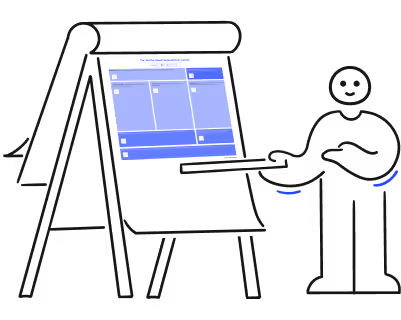What’s a learning management system? A guide for HR and L&D

Empower your organization with the skills-based canvas.

Some businesses rely on general-purpose tools like YouTube and PowerPoint to share training content. But as learning needs grow more complex, these tools fall short. That’s when the benefits of a dedicated learning system (or LMS) become clear.
But what exactly is the purpose of a learning management system, and how do the key features drive business impact?
Types of LMS platforms and how they work
Let’s start with a quick definition of LMS: A learning management system is a digital hub that centralizes training content. It lets HR and L&D teams design, deliver, and measure organization-wide learning from a single, easy-to-use interface.
Cloud-based software-as-a-service (SaaS) platforms are the most common types of LMS. The LMS provider hosts the platform and oversees its maintenance, charging a monthly or yearly subscription fee (usually per user). Learners can access the platform from anywhere, on any device.
Other common LMS types include:
- Open-source: Provides source code anyone can freely use, modify, and distribute. Offers complete customization flexibility with no licensing costs.
- Proprietary or on-premise: Vendor-owned software hosted by businesses on their own servers, providing total data control for strict regulatory requirements.
Unlike cloud-based options, both open-source and proprietary LMS platforms require in-house expertise. The HR, L&D, or IT team is responsible for managing deployment, customization, system maintenance, security, and support.
That’s why cloud-based learning platforms are a top pick for most organizations. They offload infrastructure management, deliver automatic feature and security updates, and scale on demand as your workforce grows.
Learning experience platforms vs. training management systems
A learning experience platform (LXP) is user-focused software that aggregates, curates, and delivers personalized learning content from multiple sources. A training management system (TMS) is administration-focused software that manages the documentation, tracking, and reporting of training programs.
Most advanced LMS platforms offer core LXP and TMS functionalities (and then some). Think of an LMS as a unified, wide-in-scope hub for personalizing, curating, delivering, and administering end-to-end learning programs.
Why use a learning management system?
An LMS helps HR and L&D teams digitize, centralize, and scale training while reducing overhead and improving outcomes. Here’s how the right platform can drive value across your organization.
Reduced training costs
Manual L&D training programs are expensive, mostly due to ongoing administrative overhead. Tack on costs for venues, travel, instructors, and printed materials, and expenses add up fast.
Cloud-based LMS software platforms reduce that waste. They digitize training at scale, giving learners access to materials any time, from anywhere — a must for distributed teams. With a cloud-based LMS, HR and L&D can manage creation, deployment, updates, and tracking from one centralized platform.
Automated programs
Automation brings serious efficiency to L&D. It cuts time spent on repetitive tasks and supports consistency across training programs through features like:
- Recognition systems: Automatically track progress, send kudos, notify managers, and celebrate wins without letting anything slip through the cracks.
- Standardized programs: Enforce consistent training standards across teams by deploying repeatable, high-quality content.
- Seamless compliance management: Stay audit-ready with automated mandatory training tracking and built-in reporting tools.
Optimized, data-driven insights
From company-wide skill gaps to individual learning bottlenecks, the right LMS gives HR and L&D teams a clearer picture of how development programs are performing and where to focus next.
Common LMS challenges (and how to handle them)
Interoperability, ease of use, and organizational buy-in are critical to LMS success. But they’re also common stumbling blocks. The good news? You can manage these challenges with the right approach. Here’s how to get ahead of them.
Integration gaps
Your LMS should connect seamlessly with the tools your team already uses. While many LMS platforms offer built-in integrations, it’s worth double-checking compatibility, especially for your key workflows.
User friction
Even the most feature-rich learning management system won’t make an impact if your team finds it confusing or clunky. Look for LMS platforms with an intuitive design and test usability with a few key users before rolling it out more broadly.
Buy-in
Adoption takes time, especially with something as foundational as an LMS. Bring stakeholders into the selection process early, offer hands-on training, and clearly communicate the value it brings to their day-to-day.
Key components of a learning management system
LMS platforms support a wide range of training programs, from onboarding and leadership development to ongoing compliance training. These features play a key role across all use cases:
- Artificial intelligence (AI): AI is increasingly central to LMS functionality. It creates personalized learning paths, predicts skill gaps, and automates content generation and program recommendations.
- Real-time analytics: The best LMS programs automatically capture training data and surface insights via dashboards. Many also recommend next steps and trigger follow-up actions based on learner progress.
- Content authoring: HR teams can build and tailor training content directly in the platform. Advanced LMS platforms also include AI-powered tools to help structure, write, edit, and find gaps in learning material.
- Automated workflows: From user enrollment to certification tracking, automation simplifies training management with minimal manual effort from L&D.
- Localization: Beyond translation, localization adapts content to regional languages, cultures, and compliance standards. AI helps scale this functionality with better accuracy and relevance.
- Gamification: Built-in gamification features like points, badges, and leaderboards boost learner motivation and make training more engaging.
- Social learning collaboration: Discussion forums, live chats, and other peer-to-peer tools help teams learn together. Modern LMS platforms seamlessly embed social learning features into training workflows.
How to choose a learning management system platform
The LMS market is crowded, and most platforms look similar on the surface. But the right choice helps you avoid the common pitfalls we outlined above, setting your team up for success. Your best-fit platform will depend on your goals, your team, and how it fits into your broader learning strategy. Here are four things to consider before you decide.
1. Strategic fit
Every business has unique L&D goals. Before evaluating LMS platforms, get key stakeholders aligned on your L&D objectives. Use these questions to clarify your needs:
- What learning outcomes and use cases must the LMS support?
- What pain points should it solve in our current training programs?
- Do we need an all-in-one LMS or a system built for a specific need (like compliance)?
- How well does the LMS align with our long-term growth plans?
- What level of customization and scalability do we need?
- What features are absolute must-haves versus nice-to-haves?
2. Total price
Most SaaS LMS vendors charge monthly per user. LMS pricing starts at around $2,000 for 25 users and scales with headcount. Expect to spend $20,000 or more for 1,000 users.
In addition to subscription fees, consider:
- Add-ons like analytics modules or premium support
- Migration fees for moving existing content and data to the new LMS platform
- One-time set-up fees (not applicable for Workleap LMS, which is free to start)
3. User-friendliness
Complex LMS platforms lead to friction and higher support needs, so widespread adoption hinges on ease of use for both learners and administrators.
Pilot testing helps. Have a group complete key tasks, tracking where they get stuck or need assistance. If your pilot group struggles with the LMS, be prepared for adoption challenges and higher training costs.
4. Interoperability
Without solid integrations, you risk data silos, duplicated work, and unnecessary complexity. But the best LMS will slot seamlessly into the systems you already use.
Look for platforms that:
- Follow open standards (SCORM, xAPI)
- Offer pre-built connectors and secure APIs
- Export learner data in common formats
- Apply encryption and role-based access controls across all integrations
Advanced LMS systems check all these boxes, creating a unified, secure, and scalable learning environment.
Learning, simplified
Workleap LMS makes it easy for HR to create and manage training and for learners to complete it. With built-in AI automation, Workleap streamlines every step of your L&D programs.
From AI-powered course creation and automated learner enrollment to compliance tracking and real-time insights, Workleap LMS takes the complexity out of learning management.
FAQs
What is LMS technology?
LMS stands for learning management system — a software platform that helps organizations create, deliver, and track training programs. LMS technology centralizes learning in one place, making it easier to manage content, monitor progress, and support employee development at scale.
How does an LMS support employee training?
LMS systems simplify employee training by centralizing eLearning content, automating onboarding, and tracking progress in real time. They give HR and L&D teams the tools to deliver a consistent, scalable learning experience, from onboarding and compliance to ongoing skill development.
What’s the application of a learning management system in the workplace?
An LMS supports everything from onboarding and compliance training to upskilling and leadership development. By centralizing learning and automating key workflows, LMS software helps HR teams track progress and measure impact across the organization.
%20(1).png)

%20(1).avif)


.avif)
.avif)








